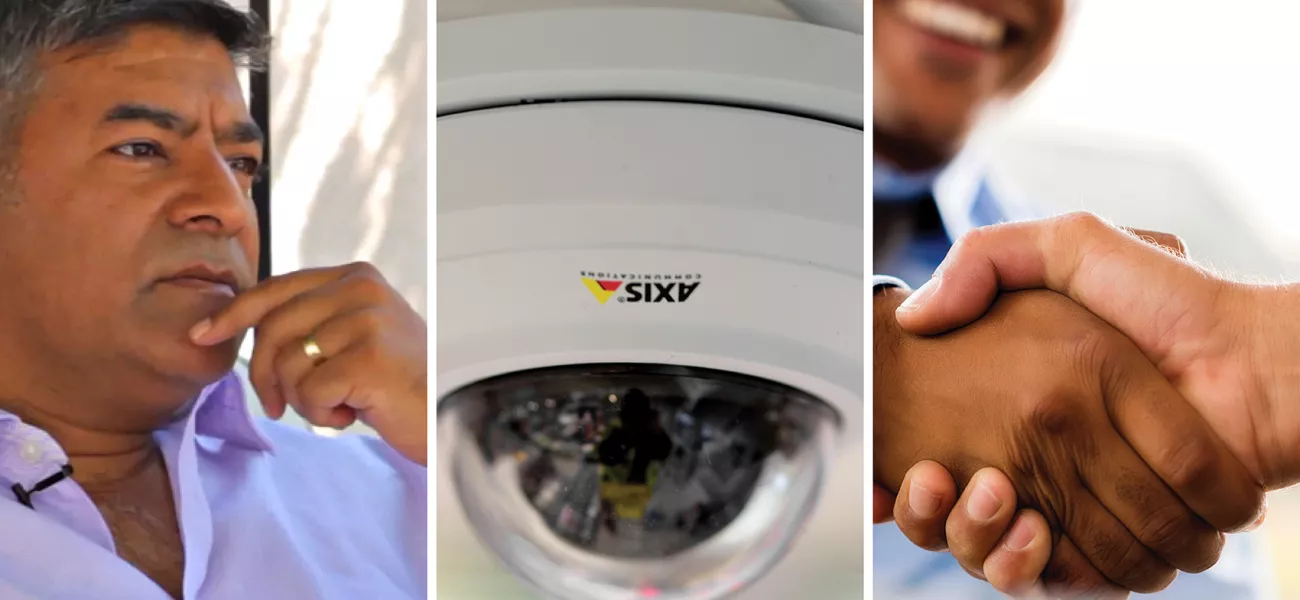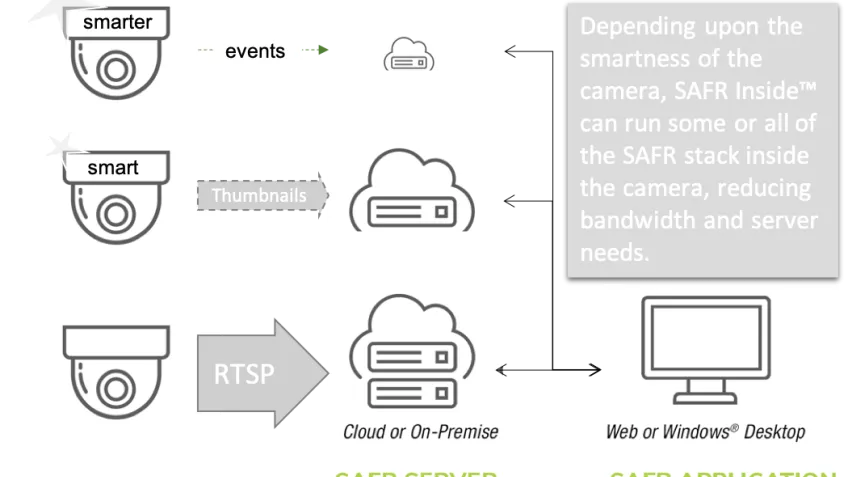
Axis has built its business around strong partnerships. Distributors, systems integrators, application developers and contract manufacturers and, of course, thousands of suppliers – it is the partner ecosystem that is built around Axis which brings innovation and quality to customers. For SAFR , a leader in computer vision analytics, it was important to find a partner which not only shared the same values, but which has created the technology which would enable it to deliver on its vision. In Axis – and particularly the AXIS Camera Application Platform (ACAP) – it found both.
SAFR (pronounced ‘safer’) is part of RealNetworks, a company which will be a very familiar name to most people who have been working in the technology sector for any length of time. Formed in 1994, RealNetworks effectively invented streaming of video media, and the company’s RealPlayer media streaming plugin and later app will have been what many of us used to watch online and offline digital video in the earlier days of our internet use.
We caught up with Reza Rassool, RealNetworks Chief Technology Officer, to find out about the origins of SAFR, how it came to be a partner of Axis and the benefits that the AXIS Camera Application Platform (ACAP) has brought the company.
From streaming video to video surveillance analytics: not such a great leap

As Reza explains, the seeds for SAFR were sown during an internal initiative looking to embed the use of Artificial Intelligence (AI) into all of RealNetworks’ product lines: “We were looking at how AI could create efficiencies, improve performance and create new solutions in all areas of the business. One of these was the backing up of mobile phone camera rolls, and within that more effective and accurate indexing of photographs. We developed an application to index images by the faces within them and found that it ranked incredibly highly for accuracy against comparable solutions.”
The CEO of RealNetworks, Rob Glaser, challenged Reza to develop the application for use with live video and, in particular, the images created by video surveillance cameras.
It was around this time that SAFR as a brand was created, and the name is telling: “From the very start, we knew that the technology we were creating would be applied to make people safer, which prompted the name. Little did we know at that time that we’d eventually partner with Axis, a company which also puts ‘safer’ right at the centre of it vision,” says Reza.
With a team in Europe working on the AI model, Reza and his team soon had a server-based analytics solution indexing facial images in live video to an extremely high degree of accuracy.
But as Reza continues: “We always knew that the application was destined to be embedded in the surveillance camera itself. While it was going create some discomfort to move from server to camera, it’s the sort of challenge our team responds to. It was also one which suited our design philosophy of creating highly efficient code – small and fast is in our DNA. The real-time streaming protocol, RTSP, invented by RealNetworks, is already in most cameras. But we needed to find the right partner with the technology that would allow our computer-vision application to run on the edge of the network.”
A meeting of technology and values
In 2019, Reza and RealNetworks CEO Rob Glaser were walking the floor at security trade show ISC West, and were impressed not only by the Axis technology on show, but also the company’s openness in allowing partners to develop on the latest version of Axis technology and, critically, the common values between the companies.
“While a lot of the initial conversation focused on technology, it was also an opportunity to get an insight into the philosophy and values of Axis, which is something that is very important to us, and the support Axis gives to its development partners,” expands Reza.
Following initial meetings, SAFR joined the Axis Application Development Partner (ADP) program and, with it, was able to utilize the AXIS Camera Application Platform (ACAP).
The benefits of moving to the edge
For many Axis partners, creating analytics applications that sit on the edge of the network – embedded in the camera itself – is an attractive proposition.

Traditionally, in server-based analytics – due to the size of images and in an effort to reduce the bandwidth requirements – video is compressed before transfer and decoded on the server for analysis. This means removing some image information; information that may affect an analytics application working in an optimal way. In edge analytics, one of the primary benefits is in having the analytics take place closer to the source of the image.
More specifically, this means that analytics is applied to the full ‘RAW’ version of the images – the highest possible quality, unaffected by any compression – which can improve accuracy. Camera-based analytics can also reduce latency, the time it takes for images to be analyzed and actions to be triggered. In scenarios where seconds can make a significant difference to public safety, such time savings can be critical.
In addition, when analytics takes place in the device itself, only the relevant data is sent across the network. This results in significant savings in bandwidth costs and storage and reduces the need for video decoding and computing hardware in the data center. This also reduces overall network traffic and allows more cameras to exist on the same network infrastructure. Scaling of a solution also becomes more straightforward: adding more analytics-enabled cameras is generally less complicated and expensive than adding more servers.
Finally, in some specific use-cases it can also be important for privacy reasons that no images are actually leaving the device, but simply output-data to other systems.
Supporting SAFR’s vision as new use cases emerge
Reza highlights the benefits of ACAP and the collaborative work: “The ACAP software development kit (SDK) gives us access to the Axis hardware and, together with the support from Axis, enables us to innovate rapidly. Particularly being able to develop for the AXIS Q1615-LE Mk III - the first Axis camera that includes a deep learning processing unit (DLPU) – was instrumental in moving our application from the server to the edge of the network, in the camera itself. Working on the application while the pandemic evolved also allowed us to create specific applications for the changes we were seeing in the world.”
A number of key use cases have emerged from the pandemic where SAFR’s application can be applied to immediate benefit. The wearing of masks in order to prevent the spreading of infection is now mandatory in many environments, and with a 95% accuracy in detecting whether a mask is being worn or not, SAFR’s applications can play a central role in public health.
In addition, as highlighted in key trends for 2021, low- and no-contact technologies are seeing significant growth, given their contribution to limiting the spread of the virus and positive impact on public confidence. Access control solutions based on facial recognition are a fast and efficient method for granting access to authorized personnel without the need for contact, and SAFR’s application is highly-accurate whether masks are being worn or not.
Two companies aligned on creating a safer world
The view of Axis on ethical business and how it wants its technology to be used is well-documented. The company’s vision of innovating for a “smarter, safer world” acts to steer every aspect of the company and how it does business. This includes not only the technology it develops itself, but that of its partners. Axis expects its partners to be transparent about how they intend their solutions to be used, to ensure alignment with Axis ethical principles.
This approach is mirrored within SAFR Guiding Principles, and Reza is not afraid to tackle the sensitive nature of the company’s applications head-on: “We have developed what we believe to be the most accurate facial recognition application for live video. The U.S. National Institute of Standards and Technology (NIST) has also rated the SAFR algorithm as having the lowest level of bias of any facial recognition solution. Like Axis, we believe that used appropriately and in line with our Guiding Principles, SAFR technology can overwhelmingly be a force for good in society. But we recognize that we have a responsibility to build consumer trust and confidence in the technology. It’s a role we take incredibly seriously.”
In our deepening relationship with Axis – in our view the most-respected company in video surveillance – and work with ACAP we’re confident that we’ll not only be developing the most advanced technology, but we’ll be building solutions that will align to both organizations’ ethical values.”
It is no surprise that the compelling benefits are encouraging more and more application developers such as SAFR to consider porting existing applications to the edge, or developing entirely new analytics applications that take advantage of the capabilities of edge analytics. ACAP represents the ideal environment to explore the opportunities.
Access tools to develop ACAP applications
- The Axis Developer Community is open to anyone interested in developing software for integration with Axis products and technologies. Designed to support individual developers as a forum for ideas, collaboration and information sharing, the community gives members immediate access to the tools needed to develop ACAP applications.
- If you are already part of Axis ADP program you find the latest ACAP tools on Axis partner pages.
